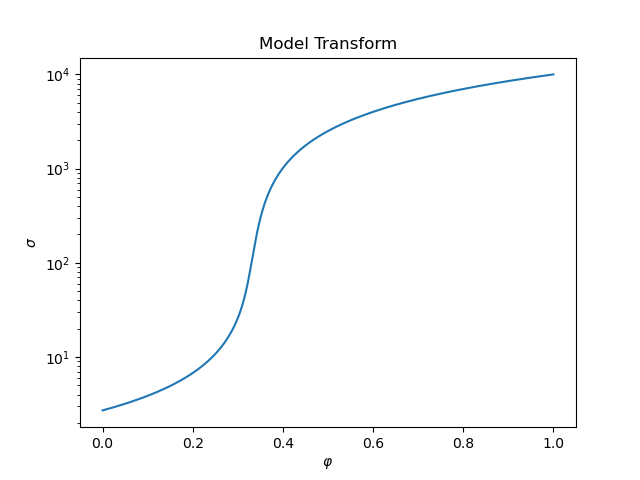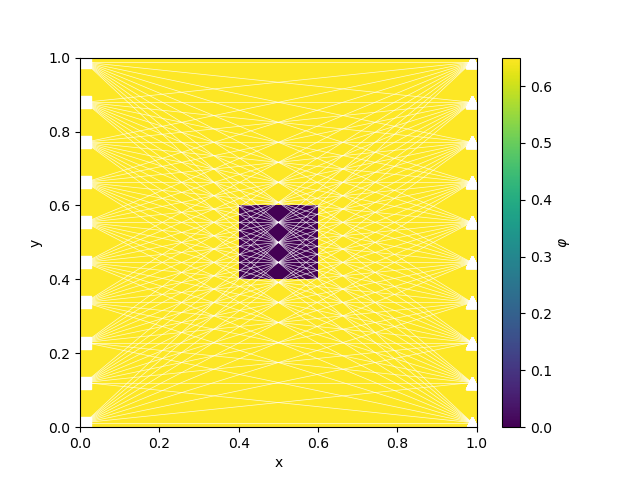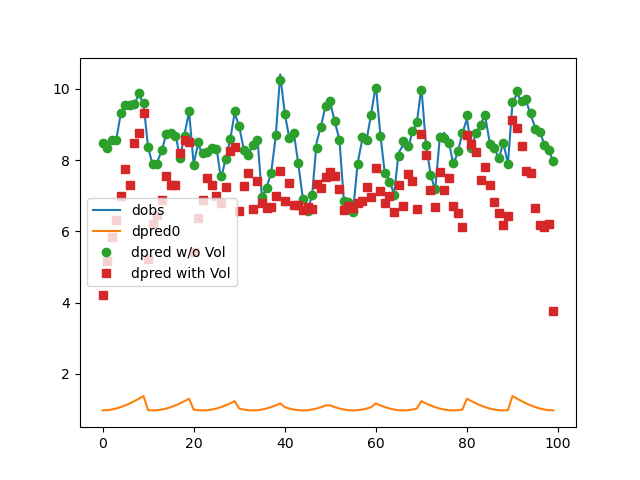Note
Click here to download the full example code
Straight Ray with Volume Data Misfit Term#
Based on the SEG abstract Heagy, Cockett and Oldenburg, 2014.
Heagy, L. J., Cockett, A. R., & Oldenburg, D. W. (2014, August 5). Parametrized Inversion Framework for Proppant Volume in a Hydraulically Fractured Reservoir. SEG Technical Program Expanded Abstracts 2014. Society of Exploration Geophysicists. doi:10.1190/segam2014-1639.1
This example is a simple joint inversion that consists of a
data misfit for the tomography problem
data misfit for the volume of the inclusions (uses the effective medium theory mapping)
model regularization
True Volume: 0.6240000000000001
SimPEG.InvProblem will set Regularization.reference_model to m0.
SimPEG.InvProblem will set Regularization.reference_model to m0.
SimPEG.InvProblem will set Regularization.reference_model to m0.
SimPEG.InvProblem will set Regularization.reference_model to m0.
SimPEG.InvProblem will set Regularization.reference_model to m0.
SimPEG.InvProblem is setting bfgsH0 to the inverse of the eval2Deriv.
***Done using the default solver Pardiso and no solver_opts.***
model has any nan: 0
=============================== Projected GNCG ===============================
# beta phi_d phi_m f |proj(x-g)-x| LS Comment
-----------------------------------------------------------------------------
x0 has any nan: 0
0 2.50e-01 4.25e+04 0.00e+00 4.25e+04 3.82e+01 0
1 2.50e-01 1.96e+03 4.98e-01 1.96e+03 3.48e+01 0
/home/vsts/work/1/s/SimPEG/maps.py:1723: UserWarning:
Maximum number of iterations reached
2 2.50e-01 2.88e+02 4.20e-01 2.88e+02 2.78e+01 0
3 2.50e-01 2.76e+02 4.14e-01 2.77e+02 2.76e+01 8
4 2.50e-01 1.34e+02 3.51e-01 1.34e+02 1.34e+01 0
5 2.50e-01 2.94e+01 3.50e-01 2.95e+01 9.85e+00 0
6 2.50e-01 1.61e+01 3.52e-01 1.61e+01 7.60e+00 0 Skip BFGS
7 2.50e-01 1.33e+01 3.53e-01 1.34e+01 6.63e+00 0
8 2.50e-01 1.20e+01 3.51e-01 1.21e+01 7.40e+00 0
9 2.50e-01 7.62e+00 3.53e-01 7.71e+00 5.80e+00 0
10 2.50e-01 6.02e+00 3.53e-01 6.10e+00 6.16e+00 0
11 2.50e-01 4.67e+00 3.53e-01 4.76e+00 4.45e+00 0
12 2.50e-01 3.93e+00 3.53e-01 4.02e+00 5.02e+00 0
13 2.50e-01 3.09e+00 3.53e-01 3.18e+00 4.15e+00 0
14 2.50e-01 2.56e+00 3.54e-01 2.65e+00 4.81e+00 0
15 2.50e-01 1.90e+00 3.53e-01 1.98e+00 3.57e+00 0
------------------------- STOP! -------------------------
1 : |fc-fOld| = 6.6088e-01 <= tolF*(1+|f0|) = 4.2470e+03
0 : |xc-x_last| = 1.3538e-01 <= tolX*(1+|x0|) = 1.0000e-01
0 : |proj(x-g)-x| = 3.5695e+00 <= tolG = 1.0000e-01
0 : |proj(x-g)-x| = 3.5695e+00 <= 1e3*eps = 1.0000e-02
1 : maxIter = 15 <= iter = 15
------------------------- DONE! -------------------------
Total recovered volume (no vol misfit term in inversion): 0.011542721350848042
SimPEG.InvProblem is setting bfgsH0 to the inverse of the eval2Deriv.
***Done using the default solver Pardiso and no solver_opts.***
model has any nan: 0
=============================== Projected GNCG ===============================
# beta phi_d phi_m f |proj(x-g)-x| LS Comment
-----------------------------------------------------------------------------
x0 has any nan: 0
0 2.50e-01 6.00e+04 0.00e+00 6.00e+04 1.48e+01 0
1 2.50e-01 3.90e+03 4.24e-01 3.90e+03 2.72e+01 0
2 2.50e-01 3.86e+03 4.09e-01 3.86e+03 2.66e+01 4
3 2.50e-01 3.76e+03 3.89e-01 3.76e+03 2.62e+01 3 Skip BFGS
4 2.50e-01 3.76e+03 3.86e-01 3.76e+03 2.61e+01 6
5 2.50e-01 3.74e+03 3.64e-01 3.74e+03 2.52e+01 3 Skip BFGS
6 2.50e-01 3.73e+03 3.26e-01 3.73e+03 2.43e+01 2
7 2.50e-01 3.72e+03 3.12e-01 3.72e+03 2.35e+01 4
------------------------------------------------------------------
0 : ft = 3.7181e+03 <= alp*descent = 3.7166e+03
1 : maxIterLS = 10 <= iterLS = 10
------------------------- End Linesearch -------------------------
The linesearch got broken. Boo.
Total volume (vol misfit term in inversion): 0.019238463032283746
import numpy as np
import scipy.sparse as sp
import matplotlib.pyplot as plt
from SimPEG.seismic import straight_ray_tomography as tomo
import discretize
from SimPEG import (
maps,
utils,
regularization,
optimization,
inverse_problem,
inversion,
data_misfit,
directives,
objective_function,
)
class Volume(objective_function.BaseObjectiveFunction):
"""
A regularization on the volume integral of the model
.. math::
\phi_v = \frac{1}{2}|| \int_V m dV - \text{knownVolume} ||^2
"""
def __init__(self, mesh, knownVolume=0.0, **kwargs):
self.mesh = mesh
self.knownVolume = knownVolume
super().__init__(**kwargs)
@property
def knownVolume(self):
"""known volume"""
return self._knownVolume
@knownVolume.setter
def knownVolume(self, value):
self._knownVolume = utils.validate_float("knownVolume", value, min_val=0.0)
def __call__(self, m):
return 0.5 * (self.estVol(m) - self.knownVolume) ** 2
def estVol(self, m):
return np.inner(self.mesh.cell_volumes, m)
def deriv(self, m):
# return (self.mesh.cell_volumes * np.inner(self.mesh.cell_volumes, m))
return self.mesh.cell_volumes * (
self.knownVolume - np.inner(self.mesh.cell_volumes, m)
)
def deriv2(self, m, v=None):
if v is not None:
return utils.mkvc(
self.mesh.cell_volumes * np.inner(self.mesh.cell_volumes, v)
)
else:
# TODO: this is inefficent. It is a fully dense matrix
return sp.csc_matrix(
np.outer(self.mesh.cell_volumes, self.mesh.cell_volumes)
)
def run(plotIt=True):
nC = 40
de = 1.0
h = np.ones(nC) * de / nC
M = discretize.TensorMesh([h, h])
y = np.linspace(M.cell_centers_y[0], M.cell_centers_x[-1], int(np.floor(nC / 4)))
rlocs = np.c_[0 * y + M.cell_centers_x[-1], y]
rx = tomo.Rx(rlocs)
source_list = [
tomo.Src(location=np.r_[M.cell_centers_x[0], yi], receiver_list=[rx])
for yi in y
]
# phi model
phi0 = 0
phi1 = 0.65
phitrue = utils.model_builder.defineBlock(
M.gridCC, [0.4, 0.6], [0.6, 0.4], [phi1, phi0]
)
knownVolume = np.sum(phitrue * M.cell_volumes)
print("True Volume: {}".format(knownVolume))
# Set up true conductivity model and plot the model transform
sigma0 = np.exp(1)
sigma1 = 1e4
if plotIt:
fig, ax = plt.subplots(1, 1)
sigmaMapTest = maps.SelfConsistentEffectiveMedium(
nP=1000, sigma0=sigma0, sigma1=sigma1, rel_tol=1e-1, maxIter=150
)
testphis = np.linspace(0.0, 1.0, 1000)
sigetest = sigmaMapTest * testphis
ax.semilogy(testphis, sigetest)
ax.set_title("Model Transform")
ax.set_xlabel("$\\varphi$")
ax.set_ylabel("$\sigma$")
sigmaMap = maps.SelfConsistentEffectiveMedium(M, sigma0=sigma0, sigma1=sigma1)
# scale the slowness so it is on a ~linear scale
slownessMap = maps.LogMap(M) * sigmaMap
# set up the true sig model and log model dobs
sigtrue = sigmaMap * phitrue
# modt = Model.BaseModel(M);
slownesstrue = slownessMap * phitrue # true model (m = log(sigma))
# set up the problem and survey
survey = tomo.Survey(source_list)
problem = tomo.Simulation(M, survey=survey, slownessMap=slownessMap)
if plotIt:
fig, ax = plt.subplots(1, 1)
cb = plt.colorbar(M.plot_image(phitrue, ax=ax)[0], ax=ax)
survey.plot(ax=ax)
cb.set_label("$\\varphi$")
# get observed data
data = problem.make_synthetic_data(phitrue, relative_error=0.03, add_noise=True)
dpred = problem.dpred(np.zeros(M.nC))
# objective function pieces
reg = regularization.WeightedLeastSquares(M)
dmis = data_misfit.L2DataMisfit(simulation=problem, data=data)
dmisVol = Volume(mesh=M, knownVolume=knownVolume)
beta = 0.25
maxIter = 15
# without the volume regularization
opt = optimization.ProjectedGNCG(maxIter=maxIter, lower=0.0, upper=1.0)
opt.remember("xc")
invProb = inverse_problem.BaseInvProblem(dmis, reg, opt, beta=beta)
inv = inversion.BaseInversion(invProb)
mopt1 = inv.run(np.zeros(M.nC) + 1e-16)
print(
"\nTotal recovered volume (no vol misfit term in inversion): "
"{}".format(dmisVol(mopt1))
)
# with the volume regularization
vol_multiplier = 9e4
reg2 = reg
dmis2 = dmis + vol_multiplier * dmisVol
opt2 = optimization.ProjectedGNCG(maxIter=maxIter, lower=0.0, upper=1.0)
opt2.remember("xc")
invProb2 = inverse_problem.BaseInvProblem(dmis2, reg2, opt2, beta=beta)
inv2 = inversion.BaseInversion(invProb2)
mopt2 = inv2.run(np.zeros(M.nC) + 1e-16)
print("\nTotal volume (vol misfit term in inversion): {}".format(dmisVol(mopt2)))
# plot results
if plotIt:
fig, ax = plt.subplots(1, 1)
ax.plot(data.dobs)
ax.plot(dpred)
ax.plot(problem.dpred(mopt1), "o")
ax.plot(problem.dpred(mopt2), "s")
ax.legend(["dobs", "dpred0", "dpred w/o Vol", "dpred with Vol"])
fig, ax = plt.subplots(1, 3, figsize=(16, 4))
im0 = M.plot_image(phitrue, ax=ax[0])[0]
im1 = M.plot_image(mopt1, ax=ax[1])[0]
im2 = M.plot_image(mopt2, ax=ax[2])[0]
for im in [im0, im1, im2]:
im.set_clim([0.0, phi1])
plt.colorbar(im0, ax=ax[0])
plt.colorbar(im1, ax=ax[1])
plt.colorbar(im2, ax=ax[2])
ax[0].set_title("true, vol: {:1.3e}".format(knownVolume))
ax[1].set_title(
"recovered(no Volume term), vol: {:1.3e} ".format(dmisVol(mopt1))
)
ax[2].set_title(
"recovered(with Volume term), vol: {:1.3e} ".format(dmisVol(mopt2))
)
plt.tight_layout()
if __name__ == "__main__":
run()
plt.show()
Total running time of the script: ( 0 minutes 30.587 seconds)
Estimated memory usage: 18 MB



